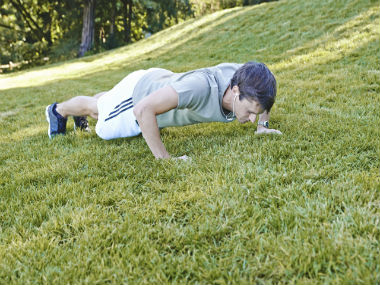Push-ups have always been used to judge a person’s fitness. A bet about strength among friends? Challenge them to push-ups. Want to impress someone at the gym? Get down for some more push-ups. Want to get a lot of likes on social media? You guessed it, push-ups for the win. Well, all those push-ups won’t be going to waste. A recent study from Harvard T.H. Chan School of Public Health, published recently in JAMA Network Open, found that push-up capacity can be an inexpensive way to determine the risk of cardiovascular diseases: at least when it comes to active, middle-aged men. [caption id=“attachment_7743121” align=“alignleft” width=“380”]
 Representational image. Image source: Getty Images.[/caption]
Representational image. Image source: Getty Images.[/caption]
Assessment of cardiac health
The traditional route to check for cardiac risk is of course by doing an electrocardiogram (ECG or EKG) which measures the electrical activity of the heart - this indicates how well your heart is functioning. The test is completely non-invasive. Another common practice is to do a lipid profile. This is a blood test that checks for abnormal levels of cholesterol - which could indicate cardiac risk. Doctors also take a complete medical history, including any family history of heart disease, as well as the person’s age, weight, diet, blood pressure, whether they smoke, what their diet consists of and how physically active they are, to gauge their cardiac health. While these tests will continue to be important, the push-up test is an interesting way for you to assess your own risk. Keep in mind that it’s a good idea to visit your doctor once a year for a general check-up, especially if you have a family history of heart disease or high cholesterol. Simple tests like ECG are cost-effective as well as painless - and they can help in early detection of problems you may have down the road.
The new research
The researchers collected the health data of 1,104 active male firefighters and did follow-ups for 10 years. The mean age of the participating men was 39.6 years and their body mass index (BMI) was 28.7. BMI is the ratio of your weight to your height. A BMI of 18.5-24.9 is considered healthy. Anything over 25 but under 30 is usually a sign that the person is overweight. At the beginning of the study, the researchers noted each participant’s push-up capacity as well as their submaximal treadmill exercise tolerance. They then categorized participants into five groups based on their push-up capacity. Each participant also completed an annual exam for the next 10 years. During the follow-up phase of the study, 37 of the participants suffered from cardiovascular diseases. Of these, 36 fell in the group that could do 40 or fewer push-ups during the initial testing, though data of how many push-ups they could do has not been shared. The researchers concluded that middle-aged active men who could do over 40 push-ups had a significantly lower incidence of cardiovascular diseases compared to ones who could do less than 10 push-ups at the start of the study.
Push-ups for the heart
Cardiovascular diseases are the leading cause of death globally. We already knew that physical activity is not only an indicator of heart health but can also prolong life expectancy - this is the first time an association between push-up capacity and cardiac risk has been studied. This test could also easily be done by individuals in the comfort of their home. Since the sample of this research is specific to men who maintain a certain level of fitness already, further testing is required to be able to apply the same learnings to a more general population and to find causation.
The right way to do a push-up:
1. Start in the full plank position: palms and toes on the mat, arms straight, body in one line. Maintain wider than shoulder distance between your palms and keep your feet together. 2. Keep your head facing the mat, don’t look at the wall in front or at your feet. 3. Bend your elbows to lower your body to the mat and stop just when your chest nears the mat (or below where your elbows are). Don’t let elbows flare out too far from your body. 4. Exhale while straightening your arms to push yourself back into the full plank position, keeping your hips and shoulder in line and moving together. This is one rep. Health articles in Firstpost are written by myUpchar.com, India’s first and biggest resource for verified medical information. At myUpchar, researchers and journalists work with doctors to bring you information on all things health. For more information, please watch our video on What Do Echocardiograms Tell Us?
)